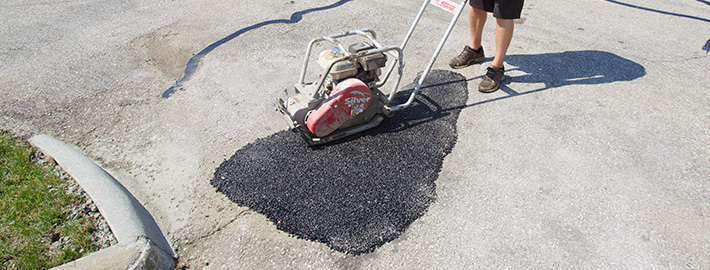Pothole Repairing Your Driveway and Parking Lot
Potholes occur when moisture seeps into asphalt and causes the material to expand and contract. Over time, the asphalt may deteriorate the materials below the surface and weaken areas of the asphalt, eventually causing potholes. Repairing the asphalt before additional damage occurs is the best way to minimize the level of repair. Depending on the level of permanency needed and pricing, there are a variety of repair solutions.
Temporary solutions like throw and roll can be done when a permanent fix isn’t necessary (often when the asphalt will soon be replaced) or when weather conditions like rain don’t allow for cleaning and drying of the damaged area.
Tikor Black handles pothole repairs and patching for small and large areas. In instances where there is large or deep damage to an area, pothole patching can be done. Surface areas are cut out and filled in with new asphalt.
Frequently Asked Questions
What causes potholes?
Potholes are generally caused by freezing and thawing of moisture alongside pressure from vehicle traffic. When moisture seeps into the asphalt and freezes, the moisture causes the asphalt to expand. When temperatures drop the moisture and pavement contracts. This pressure causes asphalt to break down over time and create potholes.
Can driving over a pothole hurt my car or tires?
In short, yes. Potholes can cause damage to your car’s tires and alignment. The speed at which you drive over a pothole and the depth of the pothole also play a factor in the level of damage to a vehicle. In a parking lot or driveway you’re chances of hurting your car are much lower than driving on a road or highway but do not eliminate the risk completely.
What are the best conditions for repairing a pothole?
Ideally, dry weather is best for semi-permanent solutions. While there are solutions available for wet/snowy conditions most are temporary fixes and allow water (that can be a primary cause of asphalt breakdown) to be mixed into the solution.
How long does a pothole repair take to dry before traffic can drive on it?
Generally, pothole patches can handle traffic after 24 hours.
How soon should I have a pothole fixed once damage occurs?
Sooner is always better than later when it comes to damage prevention. Pending traffic regularity and season, fixing a pothole within a few weeks time should be sufficient.


Leave a Reply
Want to join the discussion?Feel free to contribute!